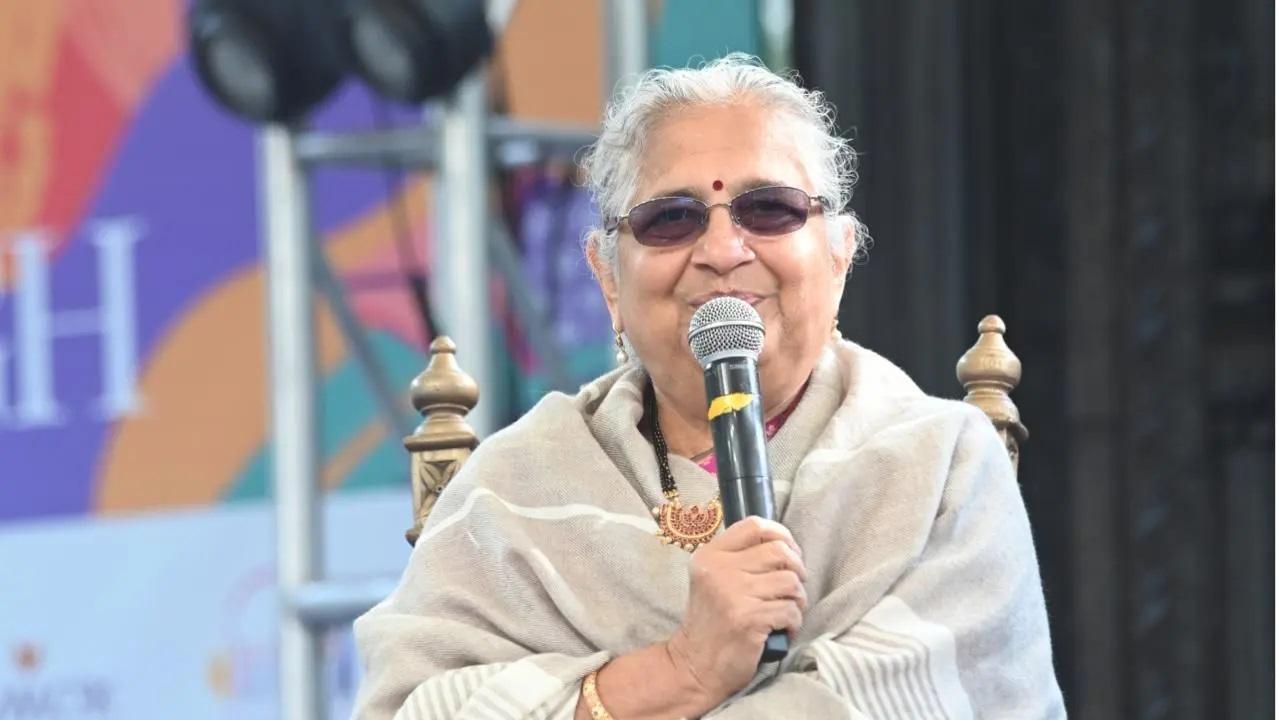In an interview with mid-day.com, Sudha Murty talks about being an author in the digital age, seeing more women work today than ever before, and her connection with Mumbai

Sudha Murty came to Mumbai for the 14th Tata Literature Live! The Mumbai LitFest. Photo Courtesy: Mid-day file pic
Sudha Murty is a multi-hyphenate celebrity today but her journey started more than 50 years ago. At a time when the men took up positions in the engineering workforce, she became the first female engineer to work with the Tatas. The change happened after she wrote a letter to the late Jehangir Ratanji Dadabhoy Tata, popularly known as JRD Tata, about the gender bias. It is a story that she proudly retells at every opportunity she gets because it is an achievement that needs to be retold for as long as women face challenges at the workplace. A lot has changed since then, and for the better, even though there is a lot more progress to be made.
ADVERTISEMENT
Speaking to mid-day.com at 14th Tata Literature Live! The Mumbai LitFest, she narrates, “After 50 years, I went to Tata Motors and there is a shop floor, where there are 300 women and no men. They are manufacturing cars. With that joy, I cried. I thought, ‘what a change my country has made, what a change my company has made and what a change those women have made’. It is so nice to see women working and asserting(themselves) and coming out and saying I will earn my own money and become independent.”
It is also why she believes that women shouldn’t listen to all the naysayers on the internet. She adds, “The thing about the internet is that this too shall pass. There will come a day but it will take time because any social change takes time. Also, women have additional responsibilities of taking care of the children. So, it affects her life to some extent, once she is married. But by and large, with good education, you can do more and that makes me very happy.”
Connection with Mumbai
Incidentally, it is not only the progress of women that makes her happy but also her connection with Mumbai where she worked at the Tatas in Bombay House between 1979-81, also picking up the mid-day newspaper along the way during her lunch break.
The educator and philanthropist, who is popular for her simplicity and wisecracks that go hand-in-hand, reveals there is more to the story. “I come to Mumbai quite often and it always makes me happy.”
As she was recently in the city to talk about her latest book at the Tata Literature Live! The Mumbai LitFest, the popularity of her book series ‘The Gopi Diaries’ is hard to miss at bookstalls and bookshops in Mumbai. Inspired by her dog Gopi, it has been immensely popular not only among children but also adults, who buy it for them, as noticed by this writer while meeting booksellers for Shelf Life with Mid-day series. So, what inspired the series? She shares, “When I saw Gopi, I thought 'what if I was Gopi?' Then how would I see other people? So, I became a dog in my mind. In three hours, I wrote what Gopi feels looking at people. I wrote the first book, then the second, third and now I'm writing the fourth book.” Such is his popularity among children that Murty reveals, “Gopi is more famous than me now.” He not only attends book sessions but also gets gifts from children like dog collars, and whenever she passes by in the car with him, kids call out to him too.
The popularity of books in general among children is understandably astonishing, especially at a time when most children are watching cartoons on screens soon after they are born. With Murty being in the middle of the transition over the last two decades, she has made quite an observation. She explains, “In the last 20 years, the change has been instant gratification. People want to see Gopi on the screen and that is a very difficult situation. How instant can you write? So, I said, ‘I will write the way I write, let them think what they have to think’.” However, she doesn’t deny the evolution and says children could indulge in both, they can either read first and then watch, or watch first and then read. Either way, they will both help the child remember what they have seen.
Being born in an era where digital platforms didn’t exist, she has always believed in reading and that is for a reason. The simplicity-personified author, who hails from Hubballi in Karanataka, and released ‘Common Yet Uncommon: 14 Memorable Stories from Daily Life’ late last year, shares, “I have always believed that reading helps you a lot in real life. I belong to a different era where we never had the digital platform. Secondly, why children or parents come to attend my session or get my book is because they feel they can bring up children with reading habits. That is the reason my books are sold more between the age group of 8 - 14 years. To understand what I've written, the parents have to read, so the parents come and sometimes if the parents don't come, the grandparents will come.”
 Subscribe today by clicking the link and stay updated with the latest news!" Click here!
Subscribe today by clicking the link and stay updated with the latest news!" Click here!







